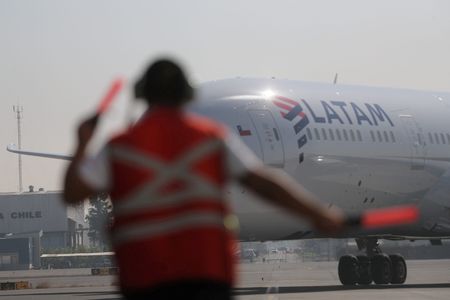By Kylie Madry
SANTIAGO (Reuters) -LATAM Airlines on Monday posted a third-quarter net profit of $232 million, boosted by higher passenger revenue and a turnaround from a loss in the same period last year when the carrier was still in bankruptcy proceedings.
The profit, which topped an analyst consensus, reverses a year-earlier net loss of $296 million, with passenger revenue jumping 26%.
Available seat kilometers (ASK), a measure of an airline’s seats multiplied by kilometers flown, rose 15%, with recovery seen especially in international flights, LATAM said.
The passenger boost plus lower jet fuel prices offset a 20% drop in cargo revenue to bring the carrier’s adjusted operational margin to 13.4%.
Third-quarter revenue, also beating consensus, rose 18% to a record $3.06 billion.
The results were “better than expected,” analysts at J.P. Morgan wrote in a client note, adding the news would likely be welcomed by the market.
The airline late last year exited pandemic-related bankruptcy with an $8 billion reorganization plan.
The airline’s adjusted EBITDAR – earnings before interest, taxes, depreciation, amortization and restructuring or rent costs – increased in the quarter by 82% year-on-year to $726 million.
Last quarter, LATAM raised its forecasts for 2023. The airline now anticipates adjusted EBITDAR of $2.35 billion to $2.50 billion, versus the previous estimate of $2 billion to $2.2 billion.
“We now think we’re going to be in the upper end of that range,” said Chief Financial Officer Ramiro Alfonsin in a call with journalists on Monday.
The carrier slightly raised its projected fleet size to 341 aircraft by 2025.
LATAM increased its revenue projection in August to $11.3 billion to $11.6 billion, from $11 billion to $11.5 billion.
Alfonsin also said LATAM expected to be in “the high end” of guidance for other metrics beyond EBITDAR, without specifying.
“We believe there is room for the company to surpass (guidance) following strong third-quarter figures,” J.P. Morgan analysts said.
The executive also said the effect of engine inspections required after RTX-controlled engine maker Pratt & Whitney discovered a rare powder metal defect would be “marginal” due to the number of aircraft that may be affected.
(Reporting by Kylie Madry, Aida Pelaez-Fernandez, Fabian Cambero, Marion Giraldo and Gabriel Araujo; Editing by Cynthia Osterman and Christopher Cushing)




